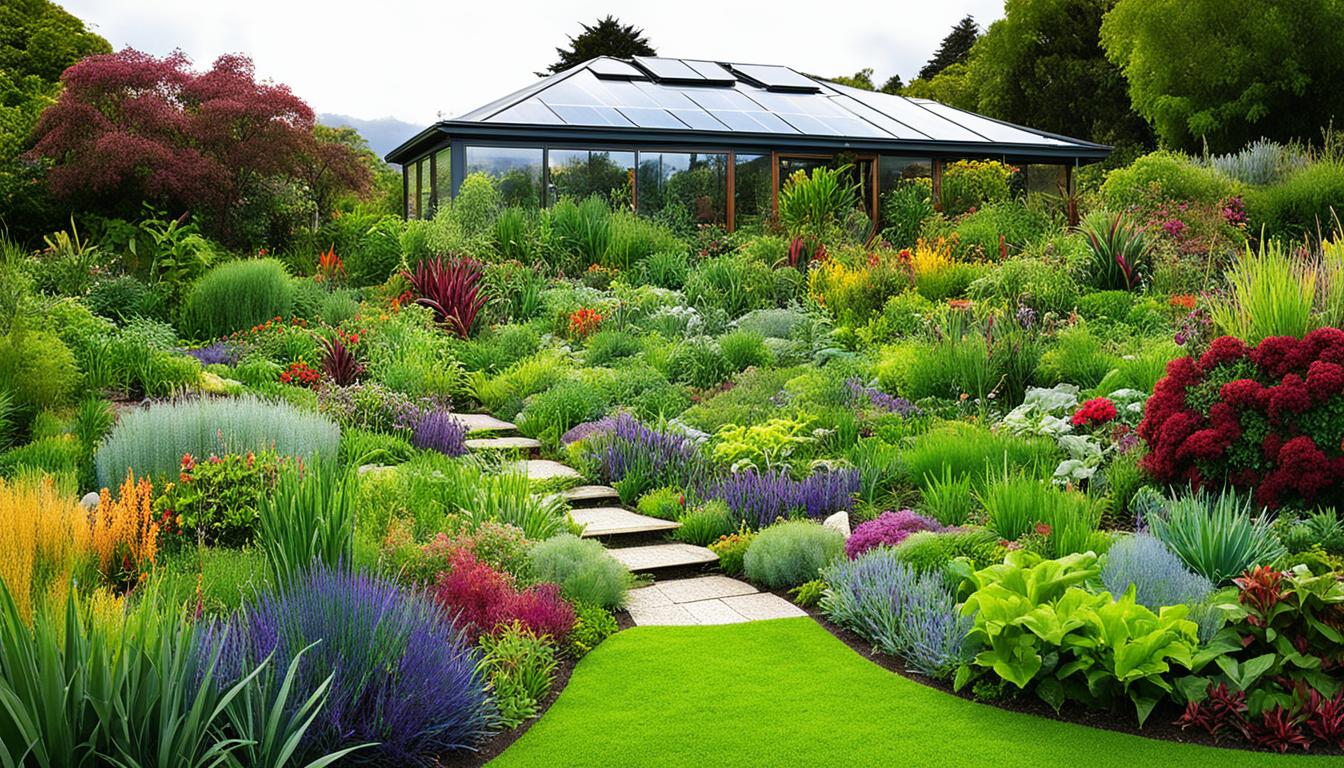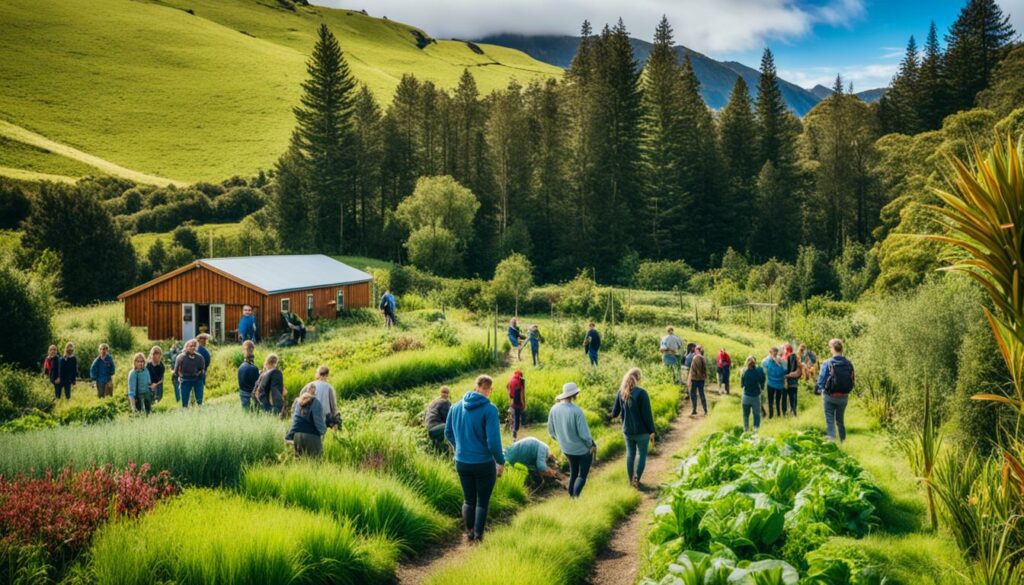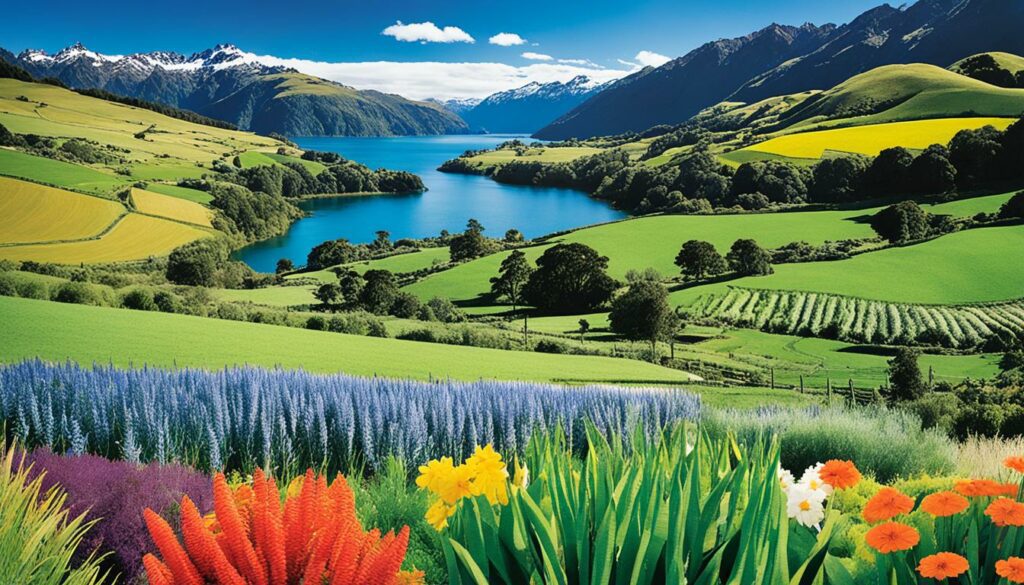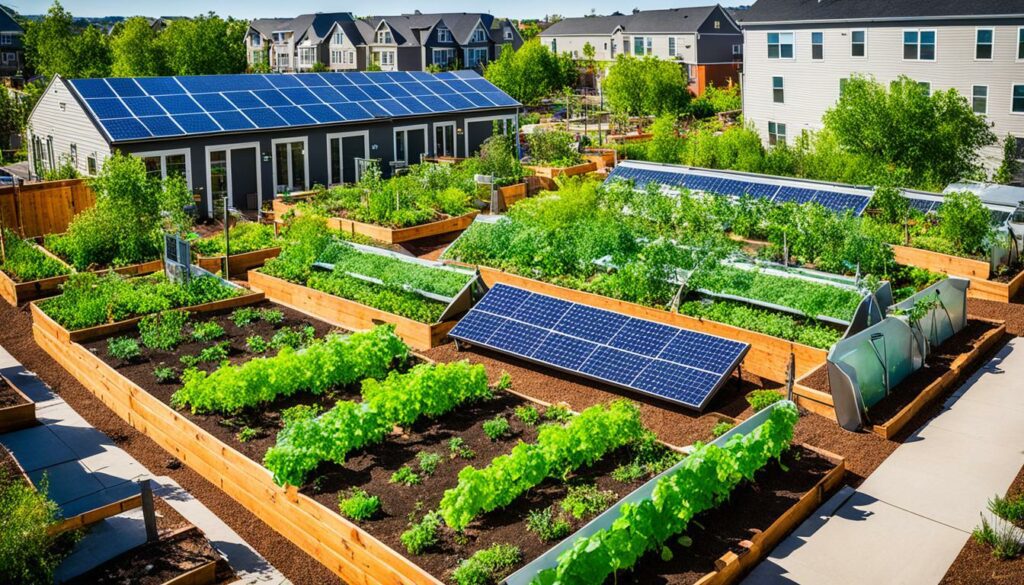Menu

Did you know a single backyard in Sydney, Australia, can give you 50 pumpkins? This comes from using permaculture principles. It shows how sustainable farming and eco-friendly ways can change our living spaces. Permaculture was first talked about in the 1970s by Bill Mollison and David Holmgren. It’s about making systems that are strong, varied, and fruitful. These systems need little from outside and work like nature, where everything has more than one job.
Permaculture isn’t just about farming; it fits all kinds of living, big or small. It focuses on taking care of the Earth, the people, and sharing resources fairly. In New Zealand, permaculture helps people build places that are independent and productive. This can be in houses, gardens, farms, shops, or even whole towns. It’s about joining back with nature and making a more lasting society.
Permaculture in New Zealand transforms how we see our link with nature. It’s an approach that ties design and living together. This way, we can do more with less and rely less on outside help. It focuses on sustainable methods, regenerating the land, owning our food supply, and saving our plant and animal species. These principles, like using different plants together, being ready for changes, and being able to support yourself, are great for facing problems such as changing climate, not enough food, and social fairness in New Zealand.
The power of permaculture shows in the numbers. A set of 15 Permaculture Design Course Pamphlet Series only costs $35 in paper form or $50 digitally, making learning affordable and easy to find. Plus, each pamphlet in the set ranges from $2 to $8.50, fitting all budgets.
When Permaculture One first came out, 25,000 copies sold in just three years. This high interest shows people are keen to learn about permaculture’s ideas.
In Australia, permaculture groups grew to 36 in just four years. New Zealand can follow this path. Also, a publication had about 3,000 subscribers who wanted to learn more. After Bill Mollison’s talks in the USA, more people wanted to join workshops. This shows how important it is to keep learning about and working together in permaculture.
The efforts towards healing the land, controlling our food source, and saving species in New Zealand’s permaculture are promising. By sticking to these ideals, we can build up communities ready for what lies ahead.
In the 1970s, Australians Bill Mollison and David Holmgren developed the idea of permaculture. Their goal was to create a lasting agricultural system. It would not just focus on farming but also on living sustainably. This initiative began in Tasmania. There, a growing care for the environment led to the birth of permaculture. It later became an international movement.
Bill Mollison, born in 1928, did many jobs before focusing on environmental work. He worked for the CSIRO and the Inland Fisheries Commission of Tasmania. With his student David Holmgren, they came up with the basics of permaculture in the early 70s. The term “permaculture” first appeared in the Organic Farmer and Gardener newsletter in 1976. Their article on a permaculture system attracted a lot of attention. This made them leaders in the permaculture field.
Permaculture has changed a lot since it began. It was first described in the book Permaculture One in 1978. In the early 1980s, the “Permaculture Design Course” pushed it further. By the 1980s, permaculture was known in many countries. New Zealand, with its unique environment, has embraced these ideas. They have used permaculture in farming and innovation. The core values, like ‘Care of the Earth’, guide these practices. They help keep the system sustainable.

Permaculture takes cues from the natural world. It aims to mimic ecosystems in human settings. In his book, David Holmgren detailed these design ideas. The system isn’t only about the environment. It’s also about improving life and economy in communities.
Permaculture relies on three central ethics. They lead people to honour the planet, look after each other, and share fairly. These guides help in making systems that last and even get better over time.
Earth Care is about our pact with nature. It urges us to save resources and renew the land. This way, we make sure the earth thrives for those who come after us. It’s an act of environmental stewardship.
People Care is about building better relationships and a fair society. It focuses on making communities strong and welcoming. Everyone’s role is seen as important, from caring for the land to other efforts.
Fair Share is all about fair use of resources. It warns against using too much and not thinking of tomorrow. This way, we balance what we take with what others need now and in the future. It’s about economic fairness.
At the 2023 Australian Permaculture Convergence, these ethics were taken seriously. Rayna Fahey from New Zealand talked about putting them into practice. She showed how they help worldwide, like with a community nursery by Permaculture Out West. This nursery helps start new plants for everyone’s benefit.
Permaculture believes in finding a balance with these ethics. It aims for a world where people and nature are both cared for. Applying these ideas not just in talks, but in daily life, makes a real difference.
Using permaculture principles is key to building systems that are both sustainable and efficient. It covers many ecological design areas. These include creating self-sufficient spaces by observing nature, using renewable resources, and aiming for zero waste.

In permaculture, we start by watching and learning from nature. This helps us design systems that work with the landscape. Understanding ecosystems shows us how to be self-reliant through their resilience and varied life.
Permaculture puts a big focus on using resources we can renew. Things like solar power, wind, and rain are key. At Murrnong Farm, they use the sun for cooking and drying food. This shows how renewables fit into daily life.
A big aim is to have no rubbish. This means creating systems where everything is used again. At Eagle Ridge Permaculture, waste from animals is turned into plant food. This approach is a strong step towards being eco-friendly and sustainable.
Adopting permaculture in New Zealand means making design changes. These changes fit the country’s many climates. The unique land, from coast to mountains, requires specific permaculture plans. This is to boost organic farming and grow the variety of plants and animals.
New Zealand has varied climate zones needing different permaculture methods. For areas near the sea, using plants that like salt and windbreaks is wise. This helps permaculture to do well in tough areas. Alpine places do best with steps for planting and crops that are okay with frost. This makes organic farming there more fruitful even when it’s cold.
Permaculture focuses on lasting farming, a contrast to the US’s major crop farming. It uses plants that come back on their own, helping the land for a long time. The Waikato River powers much of the North Island with its rivers. This shows how permaculture uses nature well. It also helps bring back natural spaces, making a home for many plants and animals. This creates a rich and balanced place to live.
| Climate Zone | Design Adaptation | Crop Examples |
|---|---|---|
| Coastal | Salt-tolerant plants, windbreaks | Barley, saltbush |
| Alpine | Terraces, frost-tolerant crops | Potatoes, kale |
Practising permaculture also boosts the types of plants and animals in an area. This not only helps the environment but the economy too. As more people discover permaculture farms, they become famous for their high-quality food. This brings in visitors from near and far.
In New Zealand, permaculture practises focus on resilient and sustainable farming methods. These methods help the environment by boosting biodiversity and improving soil health. Including trees in fields and growing various crops can bring benefits for both the land and the farmer’s pocket.

Agroforestry is key to sustainable agriculture, using trees in farming. It boosts biodiversity and offers homes for many species. Trees also keep the soil from washing away and help the land hold onto water, making the soil more fertile.
Growing many different types of crops is important for resilient farming. It lowers the chances of losing crops to pests or changes in weather. This approach also keeps the soil healthy by itself, needing less chemical help. It’s a big part of moving towards farming that not only sustains but also heals the land.
| Farming Method | Benefits |
|---|---|
| Agroforestry | Enhances biodiversity, improves soil structure, prevents erosion |
| Crop Diversity | Reduces crop failure risks, boosts soil fertility, promotes dietary variation |
| Natural Cycles | Minimizes chemical inputs, fosters regenerative farming |
Permaculture fosters a good relationship between people and the land. By using methods like agroforestry and planting a range of crops, New Zealand leads in nature-friendly farming. This way, the country strengthens its connection with the environment.
Embracing sustainable living starts at home. Applying permaculture means creating systems that feed us and save water. Tips for food forests and water-saving methods are key for any homeowner.
Build a food forest for reliable food. In New Zealand, a 2.4-acre site got a food forest. It dealt with bad soil, wild plants, and damaged land for animals.
They planted low plants like Clover and Borage, and bushes like Gooseberries. They also grew apples and other trees. This mix gives food year-round and helps wildlife.
Saving water is vital in permaculture, especially in dry times. The New Zealand site had bad-draining soil and a full septic tank. They used rainwater, mulching, and drip systems to cut water use.
By the creek, they planted with a special method and composted. Mulching keeps moisture in, stopping the need for more water.
These steps really help make your living sustainable. They grow your food and save water, making for a greener life.
In New Zealand, many permaculture success stories inspire us. They show amazing community resilience and eco-innovation. For example, in Golden Bay, projects faced various challenges. These included overgrown gardens and compacted soil. But even with issues like low pH, success is still possible. A great example is Uta and Steve’s 2.4-acre property.

The design work was thorough. It included actions to take right away, plans for the next year, and long-term goals. For example, they created a food forest. This forest included Crimson clover, Comfrey, and Borage at the bottom. And Lemon Verbena, Rhubarb, and Gooseberry helped the shrub layer. This method was very strategic.
They also integrated a timberland for wood, a cold compost system, and more. These choices helped deal with problems such as frost. Such careful planning shows the eco-innovation of permaculture. It aims for both high productivity and lasting sustainability.
Research shows permaculture can do a lot for food tourism in New Zealand. Farms using permaculture were praised for their high-quality food. This links tourism and farming in a good way. Permaculture can really boost New Zealand’s sustainable food tourism future.
These permaculture success stories in New Zealand have a big impact. They lead the way to stronger community resilience and eco-innovation. These stories set a good example for sustainable living all around the world.
The key to making communities stronger is through working together, permaculture shows us. It’s all about sharing what we have, be it resources or knowledge. This way of working together builds a powerful network that leads to sustainable development.
Sharing what we know and have is crucial for a strong community. In permaculture, this is a big part of how local groups succeed – by helping each other out. This way, facing big issues like climate change or food problems becomes easier.
Local connections are vital for permaculture communities to survive tough times and be sustainable. Places like the Earthsong Eco-Neighbourhood in Auckland prove this. They show that living and working together, sharing space and resources, can keep a community strong against any trouble.
In Auckland’s Earthsong, the YIMFY group works outside their neighbourhood on eco-projects. This shows us that joining forces beyond our community can still be very successful. It tells us that working and sharing together can really make communities last and thrive.
In New Zealand, permaculture adopts a unique approach to conserve biodiversity. It promotes the growth of local plants and designs spaces for wild animals. This strategy boosts ecosystem strength and saves New Zealand’s rich biodiversity.

In permaculture, the focus is on growing native plants to revive natural areas. This feeds the local wildlife and brings back natural balance. These efforts are key in linking people to their environment.
Wildlife corridors span essential spaces connecting natural areas. They help creatures move freely, avoiding the threat of being cut off by urban development. By using these corridors, genetic health and overall diversity of life can be maintained.
Biodiversity conservation in permaculture also relies on community works and teaching. Projects in this line stress the value of looking after nature for both people and animals. This way, the whole ecosystem thrives.
| Project Aspect | Detail |
|---|---|
| Project Duration | Two-year renovation and transformation |
| Home Energy Audits | 80 free audits provided to low-income families |
| Funding | Received to support audits and educational programs |
| Education Programs | Fee-based programs offered at half the usual price |
| Community Garden | Provided food for families in a low-decile neighbourhood |
| Insulation Strategies | Innovative, low-cost, high-performance methods |
| Outreach | Interacted with low-decile community in Whanganui |
Permaculture has benefits for people, the planet, and the economy. It’s key for economic sustainability. By promoting local food, it cuts the need for shipped-in products. This boosts self-sufficiency in areas.
Permaculture shines in its focus on growing food nearby. It uses systems that need less and give more. This means everything is used well.
It is good for the economy too. Money stays in the community. It supports local farmers and cuts down on how much food travels. This reduces costs and pollution.
It creates green jobs that help local areas. Jobs in sustainable farming, design, and farming in balance with nature are common. This supports the environment, local life, and the economy. People also get paid well.
Permaculture jobs are about fairness and sharing resources properly. They help make economies stronger locally. This benefits everyone, including in New Zealand.
Permaculture education in New Zealand is key for learning about eco-living and resilience. The APW offers a Permaculture Design Certificate (PDC) that includes twelve workshops. These sessions focus on understanding the environment, creating places for living, and designing sustainably. To get certified, you need to attend at least nine workshops and complete a design project.

These workshops are globally recognised, backed by Permaculture in New Zealand (PiNZ). They follow the teachings of permaculture pioneer Bill Mollison from the 1980s. Participants learn important permaculture skills to apply in their communities, encouraging resilience.
In 2024, New Plymouth will host many permaculture courses. They range from basic to advanced, covering topics like soil health, backyard sustainability, and food forests. These courses aim to provide deep knowledge and hands-on skills in permaculture.
| Course Name | Duration | Cost |
|---|---|---|
| Permaculture Soils and Composting Day Course | 1 Day | $100 per person |
| Introduction to Permaculture Weekend Course | 2 Days | $200 per person / $300 for two people |
| Food Forest Planning & Planting Weekend Course | 2 Days | $200 per person / $300 for two people |
Accredited courses offer real qualifications accepted by PiNZ and globally. The PDC programme includes mentorship, helping learners understand permaculture deeply. This method ensures students can use their knowledge worldwide.
The Introduction to Permaculture course covers essential topics like site design and water use. Students learn through hands-on activities that boost their practical skills. This makes the learning relevant and applicable in real life.
This education is adaptable and accessible, even in lockdowns. Different payment options and group discounts make it available to all, supporting community learning. The flexibility helps students focus on their goals, no matter the situation.
Starting permaculture can be hard, especially if you’re new or have few resources. It involves costs and finding ways to deal with pests without chemicals can seem overwhelming. But, there are ways to handle these problems and make permaculture work well.
The cost to set up permaculture can be a major hurdle. Many think it’s too expensive. However, projects like the Eco-Thrifty Renovation show this isn’t true. From November 2010, the project ran for two years and proved that sustainable living is affordable. They gave 80 free home energy audits to help people in Wanganui move towards sustainable living.
Starting permaculture step by step can help manage costs. It’s also about working together with your community and using shared resources. By doing this, you can keep costs down. And educational support doesn’t have to be expensive. The project offered free or low-cost classes and discounts for using eco-friendly ways to get there.
Permaculture aims to be kind to the earth, so using natural pest control is key. Chemicals are bad for soil and the environment. Instead, permaculture uses methods like biological controls to fight pests.
Techniques such as planting different crops together and encouraging lots of types of plants can keep pests away. The community garden in the Eco-Thrifty Renovation project is a good example. It grows food naturally and controls pests too. This shows that natural ways work and they are good for the budget.
The Eco-Thrifty Renovation project proves that permaculture methods work. They offer good results without a big price tag:
| Initiative | Key Actions | Benefits |
|---|---|---|
| Home Energy Audits | Performed 80 free audits | Improved energy efficiency for low-income families |
| Community Garden | Grew food using permaculture practices | Promoted food sovereignty and sustainable living |
| Educational Programs | Offered at reduced costs | Made eco-education accessible to all |
Using sustainable solutions for costs and pest control can make permaculture a success. Education and community help are vital. They show that permaculture is a good way towards a healthier world.

The future looks bright for permaculture in New Zealand. People there are becoming more aware of its benefits. They are starting to use permaculture to build a better, greener future.
A study in 2020 showed permaculture farms are winning recognition for their top-quality food. This is making them stand out in the eyes of gastronomic tourism experts. It means permaculture might soon be a big part of New Zealand’s agri-food tourism. The study also found permaculture fits well with sustainable tourism practices nationwide.
As the research provides a baseline for future gastronomy research focusing on permaculture practices, it underscores the broader potential for advancing ecological futures in New Zealand.
The review from people who have tried permaculture is really positive. They say these programs are doing well, with an 80% approval rate. Users also like how easy it is to take part, thanks to a flexible work schedule and clear English communication.
This praise mirrors what we’re seeing in the permaculture movement’s growth. Places offering permaculture are doing a great job, from the rooms to the meals. All this shows that as New Zealand invests more in permaculture, it’s on a path to a greener, more modern future.
Permaculture principles teach us a better way to live sustainably. They are especially helpful in New Zealand because of its unique landscape and beliefs.
Today, more than half of Earth’s people live in cities. This makes it harder for us to connect with the land and grow our own food. Permaculture helps us bridge this gap, offering skills for both city and country folk to be more self-reliant and strong.
The way we make and move food around the world is becoming a big problem. It’s bad for the planet and isn’t very efficient. New Zealand is lucky to have lots of space to grow food and not too many people. This gives them an opportunity to be more independent in feeding themselves.
By using permaculture, which includes looking after the land as the Maori concept of kaitiakitanga teaches, Kiwis can protect their land for the future. They see themselves as the Earth’s guardians.
There’s a big gap between animals and the meat we eat, a sign we’ve lost touch with how our food is made. Permaculture works to heal this rift. It reconnects us to nature in a holistic way. It’s not just about farming. It’s a way of life, focused on living well with our planet and helping our communities thrive.
New Zealand using permaculture makes a big difference. It helps locally and supports global efforts to be more sustainable. Permaculture is a solid plan, both practical and good for the Earth. It shows others a way to live in harmony with nature.
Permaculture in New Zealand is about working with nature. It involves using natural resources wisely. People aim to create systems that need less outside help and can survive shocks.
In New Zealand, permaculture focuses on farming and living in harmony with nature. It helps people and communities create places that meet their needs. At the same time, it keeps the environment rich and healthy.
The idea of permaculture came from Australians Bill Mollison and David Holmgren. They started in the 1970s. Their aim was to create an agriculture that could last for many generations. This led to a wider movement, promoting sustainable ways of living.
Permaculture’s main ethics are looking after the Earth, looking after people, and sharing fairly. We should protect our planet, care for one another, and make sure everyone has enough. This way we can live well without harming the Earth.
Permaculture’s design principles help us make systems that work well without harming the environment. They focus on using what nature gives us. This includes making no waste and using things over and over.
In New Zealand, permaculture design varies from coast to mountains. People adapt their designs to the local environment. This helps with farming and keeps New Zealand’s special places alive and thriving.
Permaculture uses many methods to farm well and take care of the land. One important way is mixing trees with crops and animals in agroforestry. It also focuses on growing different crops together to be more resilient and healthy.
At home, permaculture means growing a variety of foods and saving water. These steps give people more control over their food. They also help the planet by not using too many outside resources.
In New Zealand, permaculture has succeeded in many places, from towns to countryside. Stories show how people have come together to live better and care for the Earth. They are examples for others to follow.
Permaculture brings people together to help each other and share what they know. This builds strong local networks. People share skills and food, supporting a life that doesn’t harm the planet.
Permaculture helps protect local plants and animals by keeping their homes safe and connected. People grow native plants and let wildlife move around safely. This helps protect New Zealand’s amazing natural world.
Permaculture can boost local economies by selling more local food and creating jobs. It helps communities become more self-sufficient. This is good for the economy and the planet.
In New Zealand, there are many courses and workshops for learning permaculture. These help people learn how to take care of the Earth and grow food. They also encourage people to teach others about permaculture in their communities.
Start-up costs are a big challenge for permaculture. People work together and start small to spread the cost. Dealing with pests and diseases without chemicals fits permaculture’s aim to care for the Earth and use it wisely.
The future looks bright for permaculture in New Zealand. There’s more interest in living in ways that are good for the planet. As more people get involved, New Zealand can become a place where both people and nature thrive.